Ru-San Tan
Functional Classification of Spiking Signal Data Using Artificial Intelligence Techniques: A Review
Sep 26, 2024Abstract:Human brain neuron activities are incredibly significant nowadays. Neuronal behavior is assessed by analyzing signal data such as electroencephalography (EEG), which can offer scientists valuable information about diseases and human-computer interaction. One of the difficulties researchers confront while evaluating these signals is the existence of large volumes of spike data. Spikes are some considerable parts of signal data that can happen as a consequence of vital biomarkers or physical issues such as electrode movements. Hence, distinguishing types of spikes is important. From this spot, the spike classification concept commences. Previously, researchers classified spikes manually. The manual classification was not precise enough as it involves extensive analysis. Consequently, Artificial Intelligence (AI) was introduced into neuroscience to assist clinicians in classifying spikes correctly. This review discusses the importance and use of AI in spike classification, focusing on the recognition of neural activity noises. The task is divided into three main components: preprocessing, classification, and evaluation. Existing methods are introduced and their importance is determined. The review also highlights the need for more efficient algorithms. The primary goal is to provide a perspective on spike classification for future research and provide a comprehensive understanding of the methodologies and issues involved. The review organizes materials in the spike classification field for future studies. In this work, numerous studies were extracted from different databases. The PRISMA-related research guidelines were then used to choose papers. Then, research studies based on spike classification using machine learning and deep learning approaches with effective preprocessing were selected.
Current and future roles of artificial intelligence in retinopathy of prematurity
Feb 15, 2024


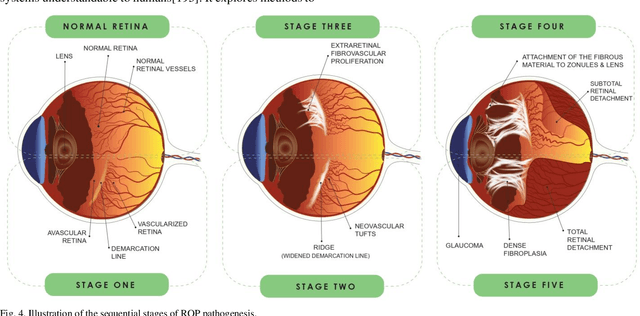
Abstract:Retinopathy of prematurity (ROP) is a severe condition affecting premature infants, leading to abnormal retinal blood vessel growth, retinal detachment, and potential blindness. While semi-automated systems have been used in the past to diagnose ROP-related plus disease by quantifying retinal vessel features, traditional machine learning (ML) models face challenges like accuracy and overfitting. Recent advancements in deep learning (DL), especially convolutional neural networks (CNNs), have significantly improved ROP detection and classification. The i-ROP deep learning (i-ROP-DL) system also shows promise in detecting plus disease, offering reliable ROP diagnosis potential. This research comprehensively examines the contemporary progress and challenges associated with using retinal imaging and artificial intelligence (AI) to detect ROP, offering valuable insights that can guide further investigation in this domain. Based on 89 original studies in this field (out of 1487 studies that were comprehensively reviewed), we concluded that traditional methods for ROP diagnosis suffer from subjectivity and manual analysis, leading to inconsistent clinical decisions. AI holds great promise for improving ROP management. This review explores AI's potential in ROP detection, classification, diagnosis, and prognosis.
Artificial Intelligence in Assessing Cardiovascular Diseases and Risk Factors via Retinal Fundus Images: A Review of the Last Decade
Nov 11, 2023



Abstract:Background: Cardiovascular diseases (CVDs) continue to be the leading cause of mortality on a global scale. In recent years, the application of artificial intelligence (AI) techniques, particularly deep learning (DL), has gained considerable popularity for evaluating the various aspects of CVDs. Moreover, using fundus images and optical coherence tomography angiography (OCTA) to diagnose retinal diseases has been extensively studied. To better understand heart function and anticipate changes based on microvascular characteristics and function, researchers are currently exploring the integration of AI with non-invasive retinal scanning. Leveraging AI-assisted early detection and prediction of cardiovascular diseases on a large scale holds excellent potential to mitigate cardiovascular events and alleviate the economic burden on healthcare systems. Method: A comprehensive search was conducted across various databases, including PubMed, Medline, Google Scholar, Scopus, Web of Sciences, IEEE Xplore, and ACM Digital Library, using specific keywords related to cardiovascular diseases and artificial intelligence. Results: A total of 87 English-language publications, selected for relevance were included in the study, and additional references were considered. This study presents an overview of the current advancements and challenges in employing retinal imaging and artificial intelligence to identify cardiovascular disorders and provides insights for further exploration in this field. Conclusion: Researchers aim to develop precise disease prognosis patterns as the aging population and global CVD burden increase. AI and deep learning are transforming healthcare, offering the potential for single retinal image-based diagnosis of various CVDs, albeit with the need for accelerated adoption in healthcare systems.
Solving the multiplication problem of a large language model system using a graph-based method
Oct 18, 2023Abstract:The generative pre-trained transformer (GPT)-based chatbot software ChatGPT possesses excellent natural language processing capabilities but is inadequate for solving arithmetic problems, especially multiplication. Its GPT structure uses a computational graph for multiplication, which has limited accuracy beyond simple multiplication operations. We developed a graph-based multiplication algorithm that emulated human-like numerical operations by incorporating a 10k operator, where k represents the maximum power to base 10 of the larger of two input numbers. Our proposed algorithm attained 100% accuracy for 1,000,000 large number multiplication tasks, effectively solving the multiplication challenge of GPT-based and other large language models. Our work highlights the importance of blending simple human insights into the design of artificial intelligence algorithms. Keywords: Graph-based multiplication; ChatGPT; Multiplication problem
Classification and Self-Supervised Regression of Arrhythmic ECG Signals Using Convolutional Neural Networks
Oct 25, 2022
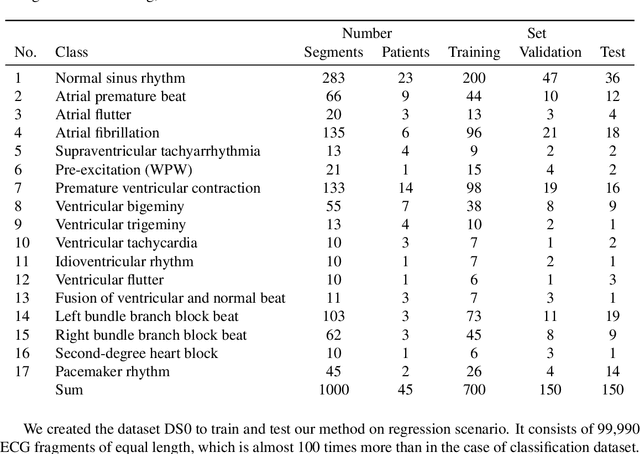
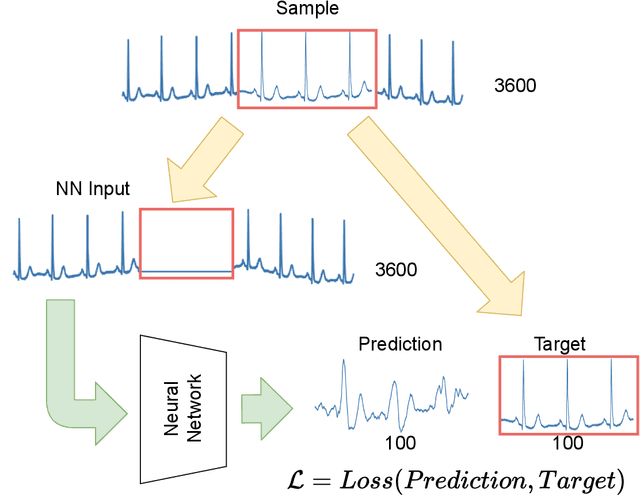
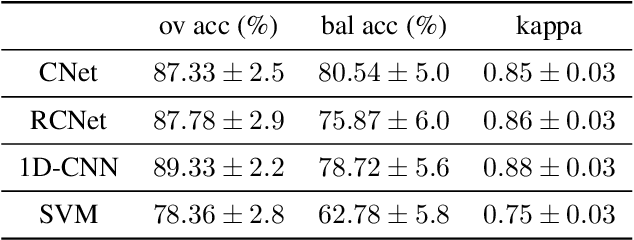
Abstract:Interpretation of electrocardiography (ECG) signals is required for diagnosing cardiac arrhythmia. Recently, machine learning techniques have been applied for automated computer-aided diagnosis. Machine learning tasks can be divided into regression and classification. Regression can be used for noise and artifacts removal as well as resolve issues of missing data from low sampling frequency. Classification task concerns the prediction of output diagnostic classes according to expert-labeled input classes. In this work, we propose a deep neural network model capable of solving regression and classification tasks. Moreover, we combined the two approaches, using unlabeled and labeled data, to train the model. We tested the model on the MIT-BIH Arrhythmia database. Our method showed high effectiveness in detecting cardiac arrhythmia based on modified Lead II ECG records, as well as achieved high quality of ECG signal approximation. For the former, our method attained overall accuracy of 87:33% and balanced accuracy of 80:54%, on par with reference approaches. For the latter, application of self-supervised learning allowed for training without the need for expert labels. The regression model yielded satisfactory performance with fairly accurate prediction of QRS complexes. Transferring knowledge from regression to the classification task, our method attained higher overall accuracy of 87:78%.
Resource allocation optimization using artificial intelligence methods in various computing paradigms: A Review
Mar 23, 2022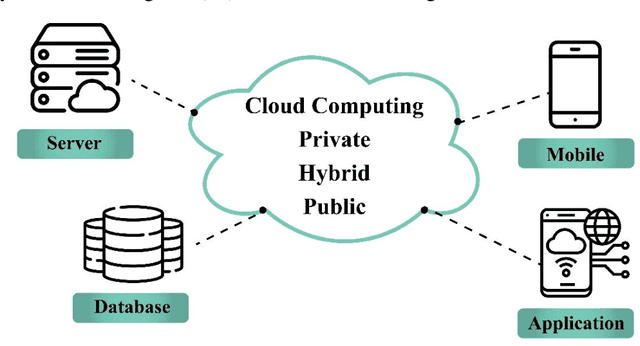
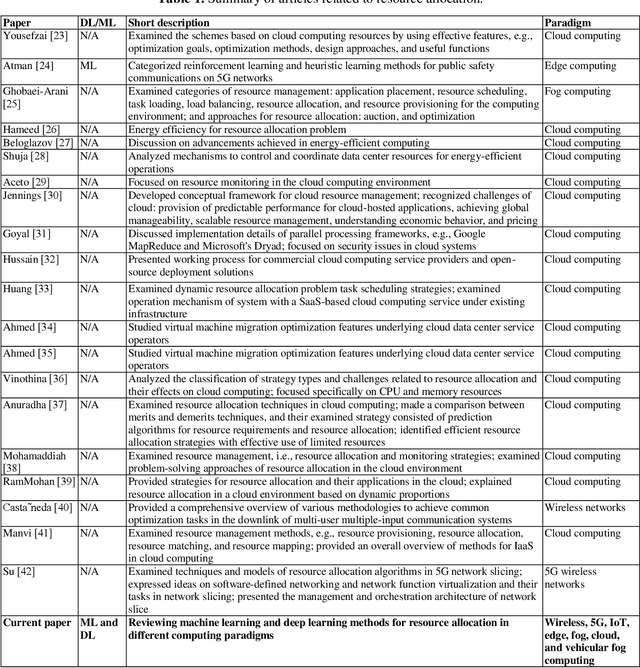
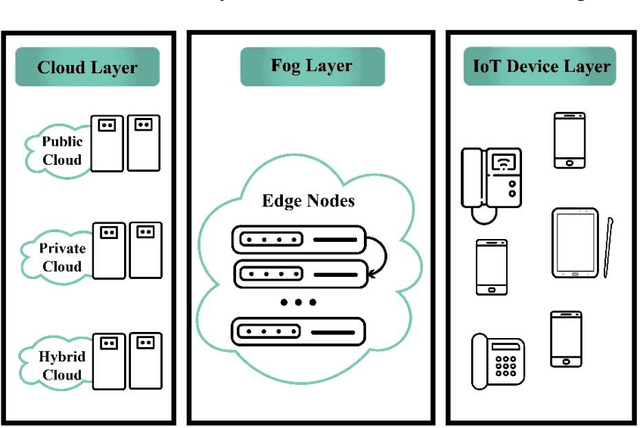
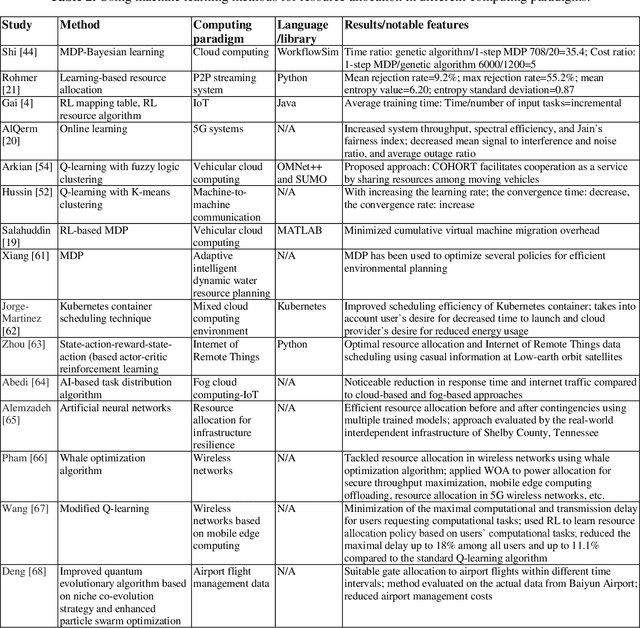
Abstract:With the advent of smart devices, the demand for various computational paradigms such as the Internet of Things, fog, and cloud computing has increased. However, effective resource allocation remains challenging in these paradigms. This paper presents a comprehensive literature review on the application of artificial intelligence (AI) methods such as deep learning (DL) and machine learning (ML) for resource allocation optimization in computational paradigms. To the best of our knowledge, there are no existing reviews on AI-based resource allocation approaches in different computational paradigms. The reviewed ML-based approaches are categorized as supervised and reinforcement learning (RL). Moreover, DL-based approaches and their combination with RL are surveyed. The review ends with a discussion on open research directions and a conclusion.
 Add to Chrome
Add to Chrome Add to Firefox
Add to Firefox Add to Edge
Add to Edge